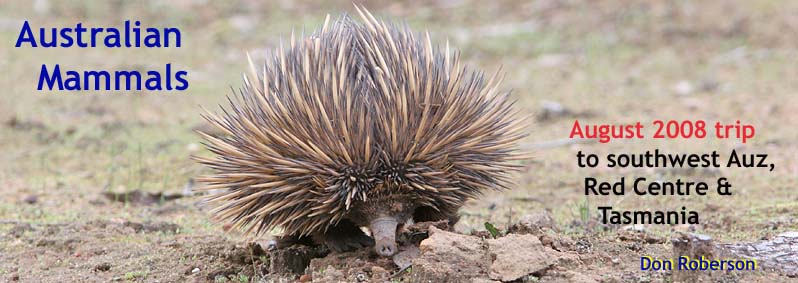
During this time we tallied 18 native mammals, excluding an unidentified rat (or antechinus?) and an unidentified bat, and many non-native European Rabbit [this includes two species that Rita saw which I missed] |
|||
 |
|||
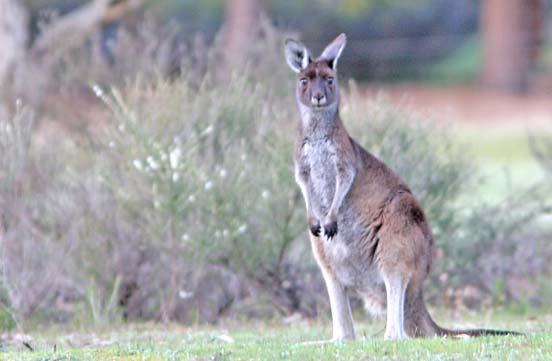 We began our trip in the extensive remnants of wondoo eucalypt woodlands in Dryandra Woodlands
reserve (above), ~4 hours drive southeast of Perth, near the wheat
country town of Narrogin. The conspicuous mammal at dusk and dawn is Western Gray Kangaroo Macropus fulginosus (right). Night drives also produced singles of Tammar Wallaby Macropus eugenii, Brush-tailed Bettong [Woylie] Bettongia penicillata, and Common Brushtail Possum Trichosurus vulpecula
(a unique form with white-tipped tail is here), plus two unidentified
rats [or were they antechinus?] and an unidentified small bat. We began our trip in the extensive remnants of wondoo eucalypt woodlands in Dryandra Woodlands
reserve (above), ~4 hours drive southeast of Perth, near the wheat
country town of Narrogin. The conspicuous mammal at dusk and dawn is Western Gray Kangaroo Macropus fulginosus (right). Night drives also produced singles of Tammar Wallaby Macropus eugenii, Brush-tailed Bettong [Woylie] Bettongia penicillata, and Common Brushtail Possum Trichosurus vulpecula
(a unique form with white-tipped tail is here), plus two unidentified
rats [or were they antechinus?] and an unidentified small bat. |
|||
| During our 3 days at Dryandra, we came upon 13 different individual Short-beaked Echidna Tachyglossus aculeatus (right & below). This seemed like an enormous number of these usually difficult-to-see monotremes, but apparently they are known to appear on late-winter days. Many were digging in rotten logs or the earth, searching for ants, termites, and beetle grubs. | |||
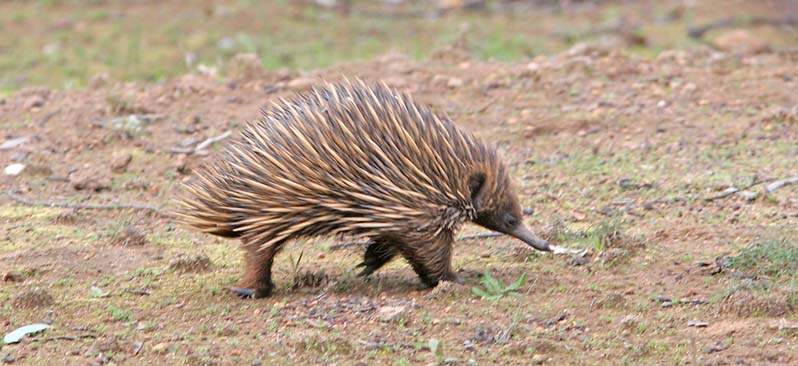 |
|||
We later watched a captive Numbat in a large enclosure at the Alice Springs Desert Park. We especially recommend that outdoor zoo for its amazing nocturnal house, where lighting has modified the times of day and night, and one can see some great nocturnal mammals up close. |
|||
 |
|||
|
|||
Our guide uses a bright red-light spotlight, which the mammals do not see as 'light,' permitting close views. No flash photography is permitted, so all my shots are are with a camera on a tripod in the red spot (below left). The rarest beast present was Bilby Macrotis lagotis (below, both photos). It is now endangered and restricted to the most remote deserts of western Australia. It shelters in a long burrow system during the day, venturing out only at night. They were once native to the Dryandra region, and it is hoped they can be re-introduced. |
|||
|
|||
|
|||
| Watching the Brush-tailed Bettong [Woylie] inside the Barna Mia enclosure enabled us to become familiar with it, and helped us recognize a wild one bounding across the road during our drive out of the woodlands later that evening. |
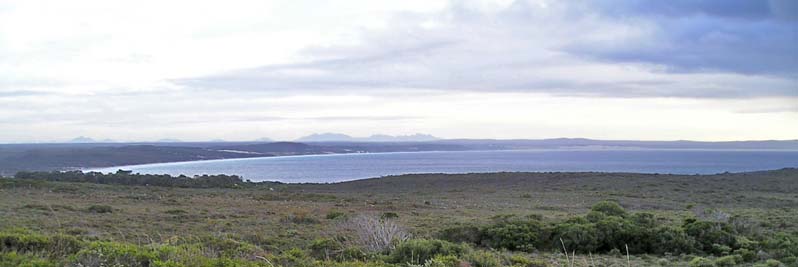 |
|
Southern Right Whale feeds in Antarctic waters in the austral summer but moves north in winter; mothers give birth in shallow bays around southern continents (like Cheynes Bay). Suckling mothers fast for 4 months while feeding the calf. The wintering pods look playful: we saw lobtails, body rolls, and flipper slaps. |
|
 |
|
The coastal heath habitat has important endemic bird species, so we were at the favored locales at dawn on several days, searching for Noisy Scrubbird [Cheynes Bay] or Western Bristlebird [Little Beach, near Two Peoples Bay]. It was near the latter spot in the pre-dawn drive that Rita saw a Quokka Setonix brachyurus hop from the road's edge into the thickets. This small, stocky wallaby is common on Rottnest Island off Perth, but we never made it out there. It is quite scarce and local on the mainland. |
|
 |
|
This species is only about 4 inches (100mm) long, with a tail of about the same length, so it is veeeery tiny — unexpectedly so! Just as cute as a mammal can be. |
|
|
|
INTRODUCTION TO AUSTRALIA TRIP August 2008 |
|
Perth to Albany, W.A. SOUTHWEST |
|
Alice Springs to Uluru RED CENTRE |
|
One day in TASMANIA |
|
page created 30 Aug-15 Sep 2008
|
© Don Roberson 2008 |
 Australia
is well-known for its impressive and distinctive mammals, particularly
the monotremes and the marsupials. We visited three far-flung and
distinctive areas of Australia in August 2008, during the austral
winter, and made an effort to see what could be seen in our timeframe:
Australia
is well-known for its impressive and distinctive mammals, particularly
the monotremes and the marsupials. We visited three far-flung and
distinctive areas of Australia in August 2008, during the austral
winter, and made an effort to see what could be seen in our timeframe: 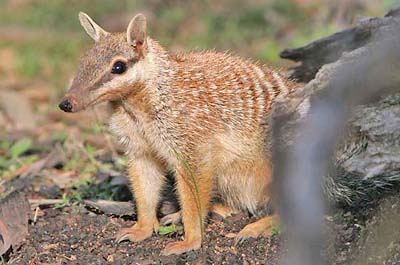 The absolute highlight of the trip — indeed, our primary goal for the vacation — was this Numbat
(left). We had planned three days in search of this elusive and
endangered mammal, and finally found this one on our 17th hour of the
search, on the final afternoon. More of the story, and more photos, are
on a separate
The absolute highlight of the trip — indeed, our primary goal for the vacation — was this Numbat
(left). We had planned three days in search of this elusive and
endangered mammal, and finally found this one on our 17th hour of the
search, on the final afternoon. More of the story, and more photos, are
on a separate 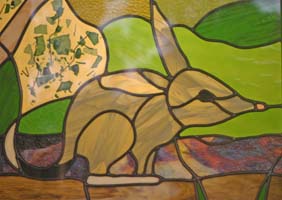
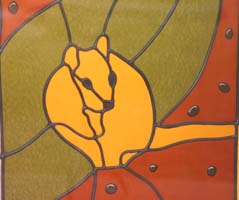
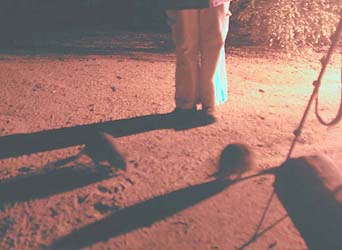 Our
guide led us to three feeding stations, and used a red spotlight to
show us the mammals. Here (right) two eager Boodies [Burrowing Bettong Bettongia lesueur] bound around Rita's feet as we start to set up tripods at the first feeding station.
Our
guide led us to three feeding stations, and used a red spotlight to
show us the mammals. Here (right) two eager Boodies [Burrowing Bettong Bettongia lesueur] bound around Rita's feet as we start to set up tripods at the first feeding station. 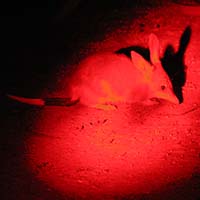

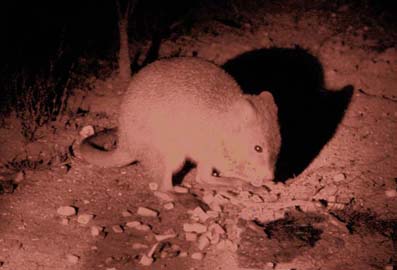
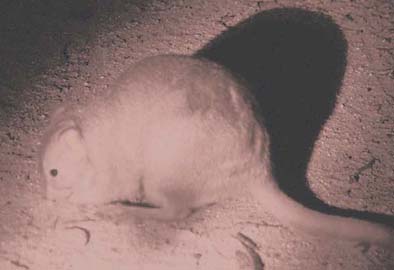
 We
spent a week in coastal heath along the coast of southwest Australia,
from Cheynes Bay (above) to Two Peoples Bay to Cape Naturaliste. Early
in the week we had periods of heavy rain (see storm clouds coming –
above). Most impressive was a small pod of Southern Right Whale Eubalaena australis
(left) very close to the shores of Cheynes Bay. One mother and calf
(below) were especially obliging; this photo was taken from shore.
We
spent a week in coastal heath along the coast of southwest Australia,
from Cheynes Bay (above) to Two Peoples Bay to Cape Naturaliste. Early
in the week we had periods of heavy rain (see storm clouds coming –
above). Most impressive was a small pod of Southern Right Whale Eubalaena australis
(left) very close to the shores of Cheynes Bay. One mother and calf
(below) were especially obliging; this photo was taken from shore.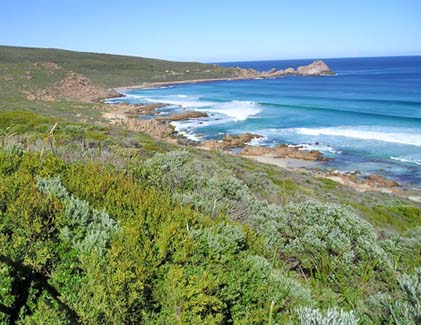 From viewing points near Cape Naturaliste (right; Sugarloaf Rock in distance), Rita spotted a pod of Common Bottlenose Dolphin Tursiops truncatus. These I managed to digiscope as they swam in the clear, near-shore waters (below).
From viewing points near Cape Naturaliste (right; Sugarloaf Rock in distance), Rita spotted a pod of Common Bottlenose Dolphin Tursiops truncatus. These I managed to digiscope as they swam in the clear, near-shore waters (below). 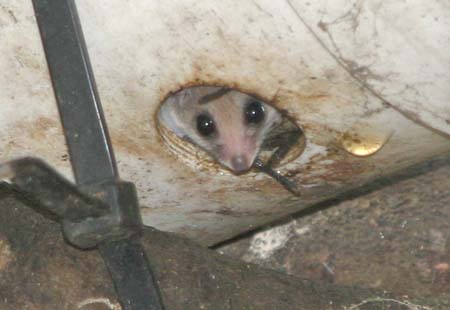 The
most unexpected mammal on the coast, though, was at the trailer
park/cottage facility at Cheynes Beach where we stayed. On inquiry, the
manager told us about some roosting tubes that had been put up for Western Pygmy Possum Cercartetus concinnus.
The possums had otherwise been roosting in electrical boxes that service
the trailers. We tried to see them at night with flashlights, but had
no success. On our final day, just before checking out, we
tapped on the roosting tubes lightly and from the final one, a pygmy
possum popped out (right). It looked at us for a moment, and then
scampered up the tree.
The
most unexpected mammal on the coast, though, was at the trailer
park/cottage facility at Cheynes Beach where we stayed. On inquiry, the
manager told us about some roosting tubes that had been put up for Western Pygmy Possum Cercartetus concinnus.
The possums had otherwise been roosting in electrical boxes that service
the trailers. We tried to see them at night with flashlights, but had
no success. On our final day, just before checking out, we
tapped on the roosting tubes lightly and from the final one, a pygmy
possum popped out (right). It looked at us for a moment, and then
scampered up the tree.